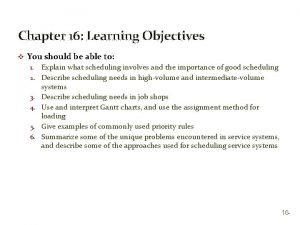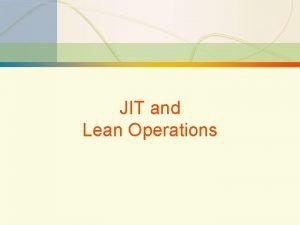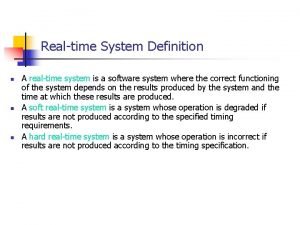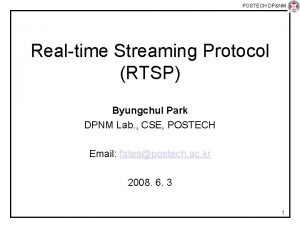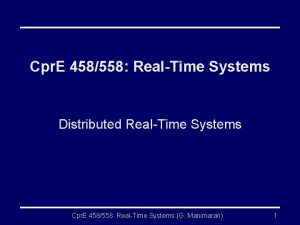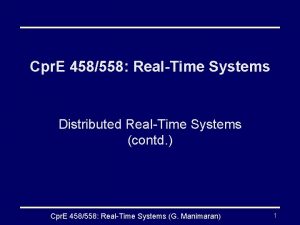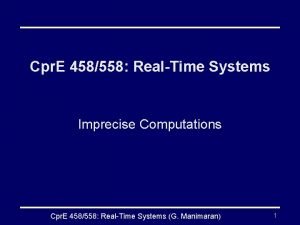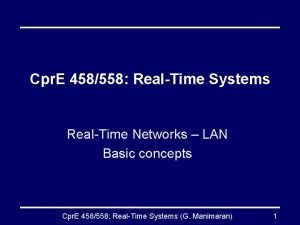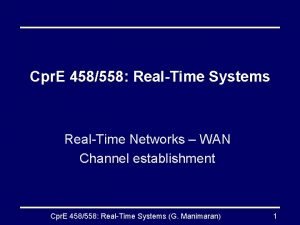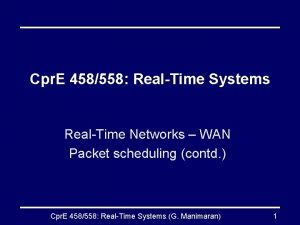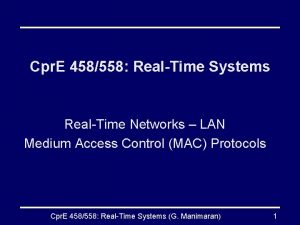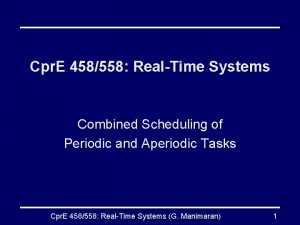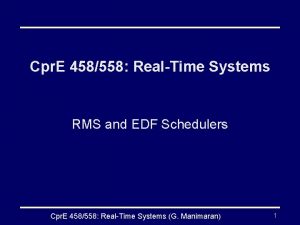Cpr E 458558 RealTime Systems Some Scheduling Results














- Slides: 14

Cpr. E 458/558: Real-Time Systems Some Scheduling Results Cpr. E 458/558: Real-Time Systems (G. Manimaran) 1

Understanding Fundamentals • Understanding the boundary between polynomial and NP-complete problems can provide insights into developing useful heuristics. • Understanding the algorithms that achieve some of the polynomial results can again provide basis for developing heuristics. Cpr. E 458/558: Real-Time Systems (G. Manimaran) 2

Understanding Fundamentals (cont. ) • Understanding the fundamental limitations of on-line algorithms will help designers avoid scheduling anomalies and misconceptions. Cpr. E 458/558: Real-Time Systems (G. Manimaran) 3

Performance Metrics • Minimizing Schedule Length. • Minimizing Sum of Completion Times. • Maximizing Weighted Sum of Values (Useful in RT systems). • Minimizing the Maximum Lateness (useful in RT systems). Cpr. E 458/558: Real-Time Systems (G. Manimaran) 4

Uniprocessor - some results • One processor, Non-preemptive, Minimizing the Max. Lateness (Polynomial). • One processor, Non-preemptive, release time constraint, Minimizing the Max. Lateness (NPhard). • One processor, Preemptive, release time constraint, Minimizing the Max. Lateness (Polynomial). Cpr. E 458/558: Real-Time Systems (G. Manimaran) 5

Uniprocessor - more results • Result: When there are mutual exclusion constraints, it is impossible to find a totally online optimal scheduler. • Result: The problem of deciding whether it is possible to schedule a set of periodic tasks that use semaphores only to enforce mutual exclusion in NP-hard. • Overload Result: There does not exist an online scheduling algorithm with a competitive factor greater than 0. 25. (this is for general case: arbitrary number of processors). Cpr. E 458/558: Real-Time Systems (G. Manimaran) 6

Multiprocessor – Some Results • Result: The multiprocessor scheduling on P processors with task preemption allowed and with minimization of the number of late tasks is NP-hard. • Result: For two or more processors, no deadline scheduling algorithm can be optimal without complete a prior knowledge of deadlines, computation times, and task ready times. Cpr. E 458/558: Real-Time Systems (G. Manimaran) 7

Multiprocessor – more results • EDF is not optimal in the multiprocessor case. • No on-line scheduling algorithm can guarantee a cumulative value greater than one half for the dual processor case. (A special case of overload result) Cpr. E 458/558: Real-Time Systems (G. Manimaran) 8

Multiprocessor; Single Deadline; Non-premptive NP-completeness is mainly due to non-uniform task execution time and resource constraints. Cpr. E 458/558: Real-Time Systems (G. Manimaran) 9

Multiprocessor – Online scheduling model Cpr. E 458/558: Real-Time Systems (G. Manimaran) 10

Multiprocessing Anomalies • Assume that a set of tasks is optimally schedulable on a multiprocessor with some priority order, a fixed number of processors, fixed computation times, and precedence constraints. • Result: For the stated problem, changing the priority list, increasing the number of processors, reducing the computation times, or weakening the precedence constraints can increase the schedule length. Cpr. E 458/558: Real-Time Systems (G. Manimaran) 11

Multiprocessing Anomalies (cont. ) • These anomalies may cause some of the already guaranteed tasks to miss their deadlines. • It can be shown that run-time anomalies cannot occur in a multiprocessor schedule when the tasks are independent. Cpr. E 458/558: Real-Time Systems (G. Manimaran) 12

Run-time Anomaly Run-time anomaly may occur when the actual computation time of a task differs from its worst case computation time in a nonpreemptive multiprocessor schedule with resource constraints. A processor is said to be work conserving if it is never idle when there is a task to execute. Any work conserving scheme may lead to run-time anomaly. Cpr. E 458/558: Real-Time Systems (G. Manimaran) 13

Run-time Anomaly – Example: Ti=(ai , ci , di ) T 1=(0, 22); T 2=(0, 12, 25); T 3=(10, 8, 26); T 4=(8, 10, 30). T 3 and T 4 have resource conflicts; Actual computation time of T 1 is 10. Cpr. E 458/558: Real-Time Systems (G. Manimaran) 14
 Job scheduling vs process scheduling
Job scheduling vs process scheduling Scheduling in high-volume systems is known by what term?
Scheduling in high-volume systems is known by what term? Scheduling in low-volume systems is known by what term?
Scheduling in low-volume systems is known by what term? They say it only takes a little faith
They say it only takes a little faith Sometimes you win some sometimes you lose some
Sometimes you win some sometimes you lose some Icecream countable or uncountable
Icecream countable or uncountable Contact vs noncontact forces
Contact vs noncontact forces Fire and ice diamante poem
Fire and ice diamante poem Some say the world will end in fire some say in ice
Some say the world will end in fire some say in ice Some trust in chariots and some in horses song
Some trust in chariots and some in horses song The definition of a real-time system.
The definition of a real-time system. Realtime aps software
Realtime aps software Firebase push notification android
Firebase push notification android Realtime streaming protocol
Realtime streaming protocol Halthywa
Halthywa

